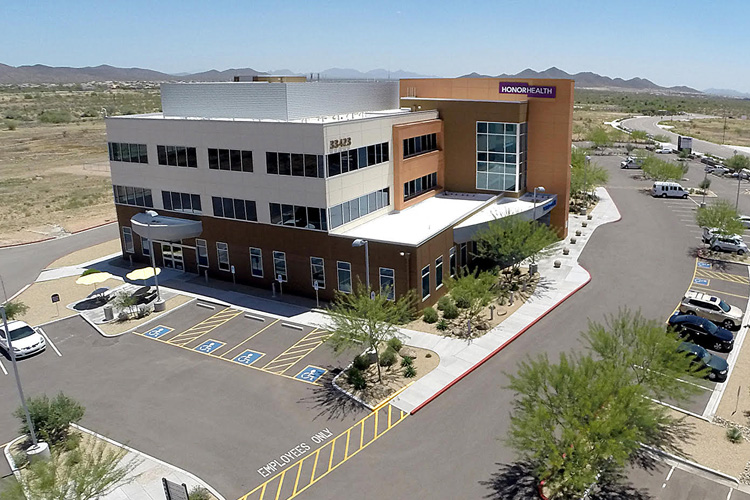The Phoenix market is growing rapidly, and to meet that growing population, healthcare companies are in the midst of a healthcare construction boom of their own.
In the north part of the Valley, work is currently ongoing on HonorHealth’s sixth hospital, the 210,000-square-foot HonorHealth Sonoran Crossing Medical Center. Also, Mayo Clinic is working on a $648 million expansion project at its Phoenix location that will double the size of its campus.
In the east, Dignity Health is adding more than 600,000 square feet of space at two locations. The largest addition will be the partnership project with Phoenix Children’s Hospital to build a new 382,000-square-foot Women’s and Children’s Tower at Mercy Gilbert Medical Center. Just a few miles west of that project, Dignity is adding a 220,000 square foot medical tower at Chandler Regional Medical Center. Banner Health is also busy in the East Valley, building a new medical center, Banner Ocotillo Medical Center, that will be 245,000 square feet.
Banner is also busy finishing up a $106 million expansion at Banner Boswell Medical Center in Sun City, while Abrazo Health recently finished expansion work at its Abrazo West Campus location in Goodyear.
The fact that these full-service, large-scale medical centers are expanding is good news for residents in the Phoenix market who need critical care. For most patients, however, a trip to a large medical center is the last thing they want to do. To reach more and more patients and provide more service and treatment options, healthcare companies are branching out.
Nationwide, the utilization of ambulatory services is on the rise. These centers offer outpatient services, including minor surgical procedures, at smaller, more manageable facilities.
“There’s always going to be a group of patients that require the level of intensive care that is found in a full-service hospital facility,” said Joan Thiel, CEO of Banner Surgery Centers. “Everybody is nervous going to a hospital, so if you don’t need to, we want to provide that option. We need to help the patient find that level of care that is safe for them and in many cases, that is becoming an ambulatory setting.”
Ambulatory care, also known as outpatient care, has been consistently on the rise. Medical care provided on an ambulatory or outpatient basis may include wellness, diagnosis, consultation, treatment, intervention, surgical, rehabilitation, and other specialty services.
“We specialize in healthcare architecture and our approach with each project is distinct to the needs of the medical care provided and the client”, said Doug Updike, senior project manager and healthcare designer for ARCHSOL, a Scottsdale-based architectural firm. “The design and functionality of the healthcare space is increasingly important, given that patient satisfaction is now tied in part to the provider’s value-based care reimbursement rates.”
In the past ten years, hospitals are diverting many services to outpatient facilities.
“We’ve got to lower the costs of healthcare and the only way to do that is to put the patient in the right setting at the right time at the right cost,” said Kris Gaw, COO of Valleywise Health (formerly Maricopa Integrated Health System). “We do so much on an acute side, but I think that the lower cost of healthcare is obviously going to be in the ambulatory setting wherever possible and inpatient beds should really be used for the critically ill.”
Thiel said Banner operates seven ambulatory surgery centers in the Valley, while Gaw said that Valleywise plans to operate 11 ambulatory locations, including three that are currently under construction. Dignity Health partners with Texas-based United Surgical Partners International, which operates 16 ambulatory care centers across the Phoenix market.
Nationwide, through September, there were a total of 166 new ambulatory care centers built or announced in 2019. In Arizona, there were six new projects. Phoenix-based OrthoArizona and United Surgical Partners International moved into a new medical office building and ASC in Gilbert. HonorHealth began construction on its Sonoran HonorHealth Medical Center which has an ASC as part of a campus expansion. Flagstaff Bone & Joint is expanding its footprint with The Flagstaff Bone & Joint Ambulatory Surgical Center and medical office building, and Phoenix-based National Cardiovascular Management is developing a medical campus that will feature a multi-specialty ASC.
The other two ASCs are the new Valleywise locations. The North clinic will be at 19th Ave. and Northern; and the South clinic will be at 35th Ave. and Southern.
“There are a couple of reasons why these providers are investing in these facilities,” according to Elissa Kelly, business development director for ARCHSOL. “One of the reasons is to expand provisions of service beyond the boundary of the hospital which in turn will improve accessibility and reduces costs. In response to retail-oriented healthcare demands, these facilities provide ease of access for consumers while also allowing providers to capture market share at an earlier point in the continuum.”
Gaw said that Valleywise Health has been very analytical in how it plans for expansions. She noted that in 2014, the voters of Maricopa County passed Prop 480 which provided $935 million for the county’s public safety net health system.
“We knew that we had to be very thoughtful, we had to be very data driven,” Gaw said. “For us, our mission is different. So we looked at that data through the lens of, ‘Where do we serve the most underserved in a very intentional way?’ ”
Valleywise used heat maps to chart where the densest population of under served residents were and looked for property in those areas to determine where to expand.
The two new Valleywise care clinic projects are being constructed at the same time by Sundt. For both clinics, Sundt will construct new, single-story 26,000-square-foot buildings on three-acre sites. Each clinic will include 24 exam rooms, an X-ray room, ultrasound rooms, lab space, and pharmacy, as well as a community learning library and classrooms. DWL Architects + Planners, Inc. is the design team behind the clinics.
Banner’s approach to ASC’s is to work with surgeons to acquire existing ASC’s where possible. If none are available in a given area, Banner will construct one if they deem it necessary.
“I think partnering with surgeons is very valuable,” Thiel said. “They want to have a high-quality surgery center to take their patients to. We want that patient experience to be as convenient as possible.”
While ASC’s have been around for quite some time, another ambulatory service that is on the rise is imaging. Ambulatory imaging services include X-rays, CT scans, MRI and other tests in an outpatient setting. Banner recently partnered with East Valley Diagnostic Imaging (EVDI) and Valley Radiologists (VRL) to provide imaging services to Banner patients throughout the Valley. Most new ambulatory care centers being built offer imaging services, which adds another layer of services at one convenient location.
“We’ve got a very good relationship with EVDI and VRL where we’re running the imaging centers and they’re providing all of the professional services,” Thiel said. “Many of them are comprehensive imaging centers. You can get an MRI, you can get a CT scan. Not only are those less expensive for the patient, but the insurance plans are in many cases saying, ‘we are not going to authorize a CT or an MRI in the hospital because we believe it can be less expensive and safely done in an outpatient imaging center.’ ”
The biggest positive about ambulatory care is the cost savings, to both the patient and the insurance companies. Most of the procedures being done at ambulatory centers are becoming less invasive and streamlined as the medical knowledge advances.
“As technology improves, both commercial carriers, as well as Medicare and Medicaid are approving more and more surgeries and procedures to be done in an ambulatory setting,” said Thiel. “It’s safe for the patient and it certainly is more convenient and affordable.”
The cost savings come from less time spent in the facility, with no overnight stays, as well as all of the costs saved on overnight staffing.
“The ability to have a patient only have to be in that facility for less than 24 hours, that in sheer nature of cost, is a big advantage,” Gaw said “The overhead costs for an outpatient facility is much less than an inpatient, so your charges that are driven to cover those expenses are relative, so that helps the patient.
“Not putting a patient into a hospital setting when they don’t need to be in one has all kinds of benefits, not just cost, but quality outcomes.”
While saving money is one tremendous advantage for the patient, the other advantage to these smaller facilities is in the peace of mind. Parking right out front and walking into a 30,000 or 40,000 square foot ambulatory facility is much less stressful than trying to navigate around a large medical center campus. Plus, for the patient, it feels more like a standard doctor’s appointment in an ASC setting.
For architectural firms that work on these project types, they design them for operational and clinical efficiency of patient care service.
“We’ve seen projects that focus on provision of service outside of acute care setting where patients are able to receive treatment in a more comfortable, relaxed setting,” said Kelly, “For example, ARCHSOL was instrumental in expanding HonorHealth’s Virginia G. Piper Cancer Care Network, a comprehensive range of ambulatory care services under one coordinated umbrella of care, by completing the design of the renovation and/or build-out of eight specialty outpatient facilities throughout the Valley.”
Updike notes that the designs and layouts of these facilities are built around the goal of creating a positive experience for patients, family and staff. They are designed with minimal “door to door” distance, smaller spaces to improve patient flow and thoughtful, comfortable finishes. There is comfortable seating, a lot of natural light and views to the outdoors, considerations that help reduce stress for patients and staff. Work spaces are also designed to provide areas for staff collaboration, as well as quiet areas.
“In an ambulatory surgery center, you’re pretty much parking near the front of the building, you’re in and out,” said Gaw. “The flow is much different.”
“We survey a segment of our patients and they tell us it’s convenient, it’s far less intimidating, the experience is a lot quicker, usually, because the turnaround time in a setting like this is better,” added Thiel. “I would say, almost universally, what we’re hearing is that it’s a much better patient experience.”




